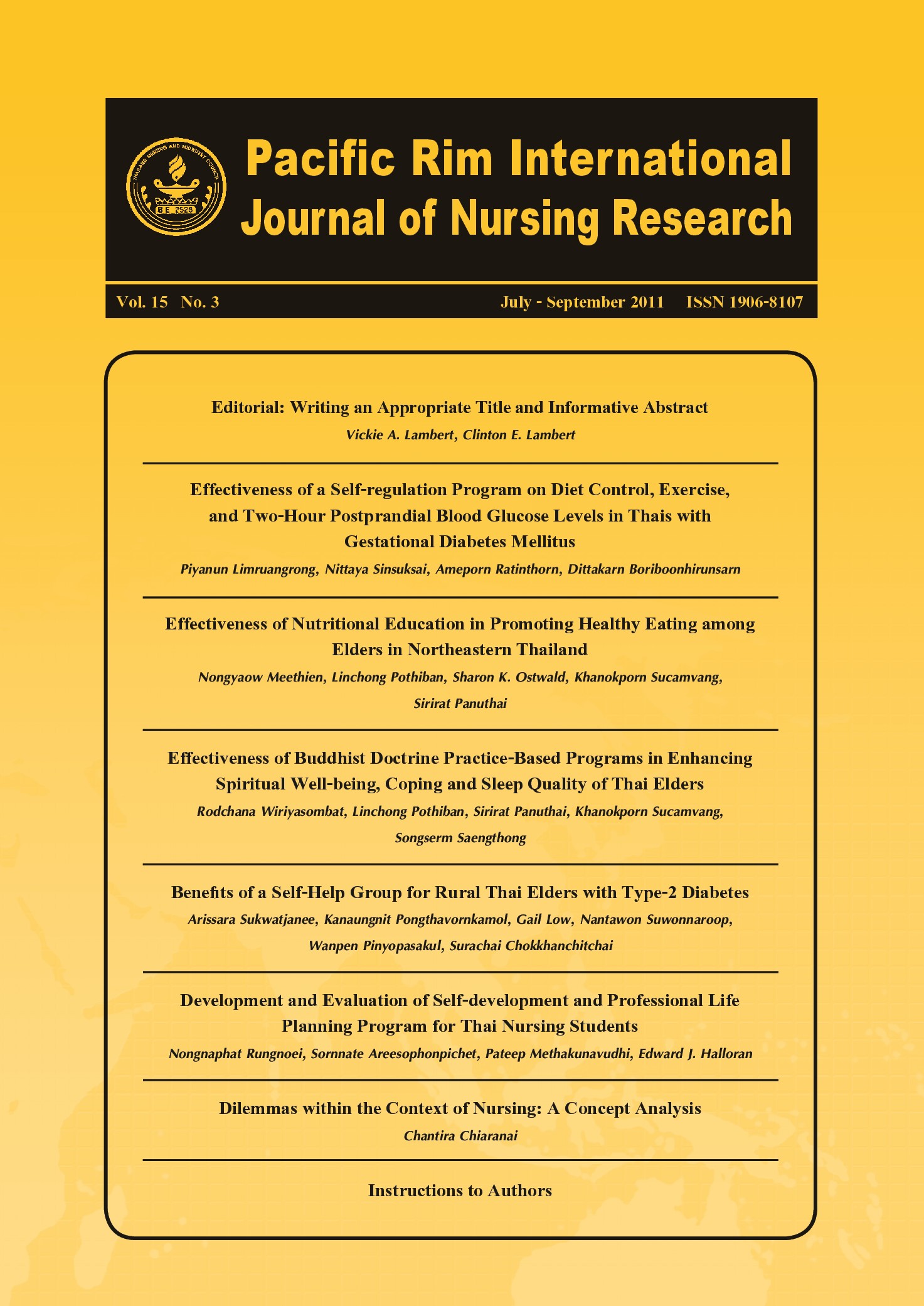Dilemmas within the Context of Nursing: A Concept Analysis
Keywords:
การวิเคราะห์แนวคิด, ความขัดแย้ง, การปฏิบัติการพยาบาล, Walker & Avant’s approach, Concept analysis, Dilemma, Nursing practiceAbstract
บทคัดย่อ
ในแต่ละวันพยาบาลเผชิญกับประเด็นความขัดแย้งมากมาย และประเด็นความขัดแย้งนั้น ก็เป็นที่ถกเถียงกันอย่างกว้างขวางในวงการวิชาชีพสาธารณสุข ยิ่งความยุ่งยากและซับซ้อนในด้าน เทคโนโลยีทางการแพทย์มีมากเพียงใด กฎหมายทางการแพทย์ก็ยิ่งซับซ้อนขึ้นเป็นเงาตามตัว สิ่งต่างๆ เหล่านี้ได้เปลี่ยนแปลง รูปแบบและระบบการทำงานของพยาบาลวิชาชีพไปด้วยเช่นกัน ดังนั้นจึงมีความ จำเป็นอย่างยิ่งที่จะต้องมีการปรับเปลี่ยนมุมมองประเด็นความขัดแย้งในวิชาชพี การพยาบาลให้มีความ เป็นปัจจุบันอยู่เสมอ ในการวิเคราะห์แนวคิดผู้วิจัยใช้แนวทางการวิเคราะห์ของของวอคเกอร์และเอแวน โดยมีวัตถุประสงค์เพื่อ นำเสนอการวิเคราะห์แนวคิดเกี่ยวกับความขัดแย้งในบริบทของวิชาชีพพยาบาล ผู้วิจัยได้ดำเนินการศึกษาค้นคว้า วิเคราะห์ และ สังเคราะห์ การนำแนวคิดของความขัดแย้งไปใช้จาก แหล่งข้อมูล และวรรณกรรมที่หลากหลาย ได้แก่ CINAHL-Nursing and Allied Health, ScienceDirect, วรรณกรรมทาง จิตวิทยา, สังคมศาสตร์, และวรรณกรรมทางด้านการบริหารการพยาบาล
จากการวิเคราะห์ ผู้วิจัยพบว่ามีการใช้ คำว่า จริยธรรม คุณธรรม และกฎหมาย ในประเด็น ความขัดแย้งทางการพยาบาล และคำเหล่านี้มีการใช้แทนกันในบางสถานการณ์ จากการวิเคราะห์ แนวคิดความขัดแย้งประกอบด้วย 5 องค์ประกอบสำคัญ ได้แก่ 1) การมีส่วนร่วม ความผูกพัน หรือการ มีคำมั่นสัญญา 2) มีทางเลือกอันไม่พึงประสงค์ทั้ง 2 ทางเลือก 3) ความจำเป็นต้องเลือกทางเลือกใดทาง เลือกหนึ่ง 4) การรับรู้ถึงทางเลือกนั้นๆ และ 5) ความไม่แน่นอนของปฏิกิริยา
แนวคิดประเด็นความขัดแย้งนั้นประเด็นสำคัญคือบุคคลที่กำลังเผชิญกับความขัดแย้งต้องมีความ รู้ ประสบการณ ์ ตลอดจนมีส่วนร่วมในสถานการณ์ความขัดแย่งเกิดขึ้น จากการวิเคราะห์แนวคิดความขัดแย้ง ผู้วิจัยสามารถจำแนกผลลัพธ์ของความขัดแย้งเป็น 2 ประการ ได้แก่ ผลของความขัดแย้งทำให้ พยาบาลไม่สามารถปฏิบัติบทบาทหน้าที่ตามขอบเขตวิชาชีพ มีสาเหตุมาจากอารมณ์ ความรู้สึก อันส่ง ผลกระทบถึงความสามารถในการตัดสินใจ ทั้ง 3 ระยะ (ทันทีทันใด, ค่อยเป็นค่อยไป, และแบบช้า) เพื่อความกระจ่างชัดผู้วิจัยได้นำเสนอกรณีกรณีตัวอย่าง (Model case) กรณีใกล้เคียง (Borderline case) กรณี Related case และ กรณีตรงกันข้าม (Contrary case) ของแนวคิดความขัดแย้ง นอกจากนี้จากผล การวิเคราะห์พบว่ามีงานวิจัยทั้งเชิงปริมาณและเชิงคุณภาพที่ศึกษาเกี่ยวกับประเด็นความขัดแย้งใน บริบทของวิชาชีพพยาบาล ค่อนข้างจำกัด กล่าวคือ ผู้วิจัยพบว่ามีงานวิจัยเชิงปริมาณเพียง 4 เรื่อง เท่านั้น ที่มีเครื่องมือวัดประเด็นความขัดแย้ง ดังนั้นจึงจำเป็นอย่างยิ่งที่จะต้องมีการศึกษาวิจัยเกี่ยวกับ ประเด็นความขัดแย้งที่มีผลต่อกระบวนการตัดสินใจของพยาบาล
คำสำคัญ : การวิเคราะห์แนวคิด, ความขัดแย้ง, การปฏิบัติการพยาบาล, Walker & Avant’s approach
Abstract
Nurses encounter numerous dilemmas, throughout their professional lives, that can become topics of heated discussion. Given the increased complexities in medical technology, laws and dynamics of professional work, dilemmas in nursing need to be examined from a fresh perspective. Thus, the purpose of this paper, using Walker and Avant’s approach to concept analysis, was to examine, within the context of nursing, the concept of dilemma. A literature search was carried out using a variety of sources, including: CINAHL-Nursing and Allied Health; ScienceDirect; and, psychological, sociological and nursing administration literature. Key words used in the search were: dilemmas in nursing; ethical decision-making; and nurses’ code of ethics.
Regarding the presence of dilemmas in nursing, ethical, moral and legal dilemmas were found to be discussed and often used interchangeably throughout the literature. Five defining attributes of dilemmas in nursing identified included: 1) involvement, engagement or commitment; 2) equally unattractive alternatives; 3) need for a choice; 4) awareness of alternatives; and 5) uncertainty of action. Antecedents of the concept were noted to be: knowledge and experience with the situation at hand; power to engage in a situation; and, a situation in which a dilemma is present. Two outcomes of a dilemma identified during the analysis were: inability to perform professionally, at an optimal level, due to feelings/emotions; and, three levels (immediate, intermediate and deliberate) of decision-making. To demonstrate the presence/absence of the concept, various cases (model, borderline, related and contrary) were used. Analysis revealed several quantitative and qualitative studies of dilemma, but only four actual quantitative instruments for measuring the concept within nursing. The results demonstrate a need for more research on the affect dilemmas have regarding nurses’ decision-making process.
Keywords : Concept analysis, Dilemma, Nursing practice, Walker & Avant’s approach
Downloads
How to Cite
Issue
Section
License
Copyright: The Pacific Rim International Journal of Nursing Research, Thailand Nursing & Midwifery Council has exclusive rights to publish, reproduce and distribute the manuscript and all contents therein.








.png)



